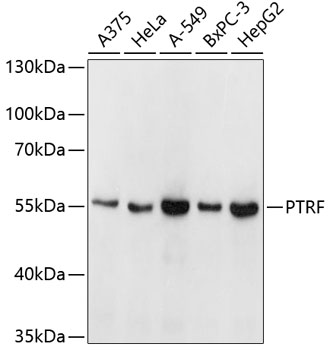-
Product Name
PTRF Polyclonal Antibody
- Documents
-
Description
Polyclonal antibody to PTRF
-
Tested applications
WB, IHC
-
Species reactivity
Human
-
Alternative names
CAVIN1 antibody; CAVIN antibody; CGL4 antibody; FKSG13 antibody; PTRF antibody; cavin-1 antibody; caveolae associated protein 1 antibody
-
Isotype
Rabbit IgG
-
Preparation
Antigen: A synthetic peptide of human PTRF
-
Clonality
Polyclonal
-
Formulation
PBS with 0.02% sodium azide, pH7.3.
-
Storage instructions
Store at 4℃. Avoid freeze / thaw cycles.
-
Applications
WB 1:1000 - 1:2000
IHC 1:50 - 1:100 -
Validations

Western blot - PTRF Polyclonal Antibody
Western blot analysis of extracts of various cell lines, using PTRF antibody at 1:1000 dilution.Secondary antibody: HRP Goat Anti-Rabbit IgG (H+L) at 1:10000 dilution.Lysates/proteins: 25ug per lane.Blocking buffer: 3% nonfat dry milk in TBST.Detection: ECL Basic Kit .Exposure time: 1s.
-
Background
Plays an important role in caveolae formation and organization. Essential for the formation of caveolae in all tissues. Core component of the CAVIN complex which is essential for recruitment of the complex to the caveolae in presence of calveolin-1 (CAV1). Essential for normal oligomerization of CAV1. Promotes ribosomal transcriptional activity in response to metabolic challenges in the adipocytes and plays an important role in the formation of the ribosomal transcriptional loop. Dissociates transcription complexes paused by DNA-bound TTF1, thereby releasing both RNA polymerase I and pre-RNA from the template (By similarity). The caveolae biogenesis pathway is required for the secretion of proteins such as GASK1A (By similarity).
Related Products / Services
Please note: All products are "FOR RESEARCH USE ONLY AND ARE NOT INTENDED FOR DIAGNOSTIC OR THERAPEUTIC USE"
